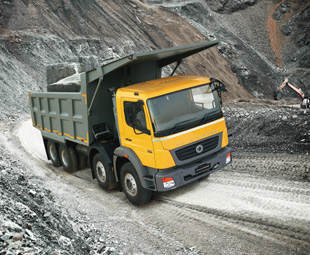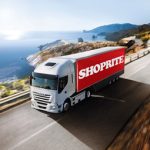Volvo pioneers dual- clutch transmission in heavyweights

In his monthly review of global news for local truckers, FRANK BEETON reports on Volvo’s pioneering entry into heavy-duty dual-clutch transmissions, reveals an interesting Japanese supply agreement between Fuso and UD, takes a look at Fuso’s market expansion activities, and brings more news on developments in the EuroVan sphere.
Volvo Trucks has certainly introduced more than its fair share of innovative features into the heavy truck arena over the past few years. Back in 2012, the latest iteration of the company’s FH Series flagship startled the world with the first application of “Individual Front Suspension”, coupled with rack-and-pinion steering, in a series production heavy truck.
This left many observers puzzling over why it had taken so long for any major truck manufacturer to venture into the realm of independent suspensions, but all credit to Volvo for taking the technological leap in the interests of greater stability and safety in high-speed operations on smooth road surfaces.
One year later, the latest version of Volvo’s FM Series emerged with “Dynamic Steering”, which combined an electric motor and electronic control unit with hydraulic power steering to further reduce driver effort and fatigue over conventional power steering, and provide exceptional on-highway directional stability.
Additional features included automatic self-centring when reversing, compensation for heavily cambered roads and side winds, and reduced effects of road surface cracks and potholes.
In the interim, the company has continued to launch innovative products, including a refreshed medium- to heavy-duty distribution FE low-cab series with an added low-entry derivative, the fourth-generation VM truck range for South America, and the latest VNX conventional (normal control) heavy-haul truck tractor for the United States (US) and Canada, which is intended for extreme operations at up to 102 t gross combination mass (GCM).
 Not content with this veritable slew of new products, however, Volvo has once again hit the pioneering trail; this time with the first heavy-duty application of a dual-clutch automated transmission.
Not content with this veritable slew of new products, however, Volvo has once again hit the pioneering trail; this time with the first heavy-duty application of a dual-clutch automated transmission.
The Swedish manufacturer has a long history of in-house transmission manufacture and development. Older readers will remember its superb synchromesh eight- and 16-speed range change units of the 1970s, which were just so much easier to handle than the equivalent constantmesh transmissions fitted by most competitors.
In 2001, Volvo introduced its own I-Shift automated mechanical design, when this type of transmission was gaining a foothold in the transport sector, and this product is widely regarded as one of the best of its type.
The dual-clutch principle was first used in Porsche racing cars in the 1980s, using a technique in which the odd- and even-numbered gear sets were each coupled to their own clutch, both of which then transmitted rotational forces to a common output shaft. By engaging and disengaging the clutches sequentially, with a small timing overlap, almost seamless gear changes from odd- to even-numbered gears were made possible. Changes can be called up automatically by an electronic control unit (ECU) or driver inputs can be used.
Since then, Mitsubishi Fuso Truck and Bus Corporation has taken the technology into the commercial arena, with the six-speed M038S6 “Duonic” dual-clutch transmission, employed in the eighth generation of its highly successful Canter light-truck family. Until now, however, it has not been found in anything heavier than the Canter, which tops out at 8,55 t gross vehicle mass (GVM).
As with most of Volvo’s recent innovations, the company has produced a video to support the launch of the I-Shift Dual Clutch transmission, and while it did not have the drama of the earlier “Ballerina Stunt” or “Splits” productions, this one clearly illustrates the impact of the seamless shifts enabled by a dual-clutch transmission. The video shows two identically loaded FH articulated rigs; one has the dual-clutch transmission, while the other is fitted with the previous generation I-Shift AMT.
From a standing start, the dual-clutch unit out-accelerates the other rig by a substantial margin up an incline, confirming the advantage. The benefits claimed by Volvo are mainly related to its improved driving efficiency and comfort, with less chance of traction loss on slippery or uneven road surfaces. Fuel consumption is said to be equal to that obtained with “normal” I-Shift transmissions.
The manufacturer also points to a potential benefit when moving livestock or liquid cargo, in that any tendency for the load to surge or be moved around would be reduced.
In our view, however, keeping the engine closer to its optimal range on the torque curve, and maintaining momentum through less torque interruptions, should logically also produce some measurable economy benefits when speed is controlled.
The I-Shift Dual Clutch transmission will be available as an option on FH Series trucks with Euro-6 D13 engines from the European autumn of 2014.
Strange bedfellows!
The bizarre, and sometimes complicated, saga of the light-truck marketing arrangements between Nissan Motor Company and its erstwhile associate Nissan Diesel (now UD Trucks Corporation), has occupied this column on a number of occasions.
Late in 2010, we reported on the announcement that UD was to cease contract production of the Atlas F24 light truck and Patrol Pickup on behalf of Nissan, and that future build of the F24 would be relocated to Auto Works Kyoto.
We commented, at the time, that Nissan Diesel had been a regular supplier of power units and complete vehicles to the larger company for 60 years, and that the two companies had exchanged “Cabstar”, “Atlas” and “Condor”-badged light trucks, and their constituent componentry, for a number of decades.
However, this arrangement had not always appeared completely comfortable, and in the mid-1990s, both Nissan and Nissan Diesel resorted to buying-in Isuzu Elf products to prop up their light-truck portfolios. After ending the contract assembly arrangement with Nissan Diesel, however, Nissan showed no signs of dropping out of this market niche, and expanded its new F24 Cabstar/Atlas programme to include manufacturing arrangements in Spain, China and India.
Then, in June, 2012, we read that Daimler-controlled Mitsubishi Fuso Truck and Bus Corporation (MFTBC) and Nissan had concluded an agreement to cooperate in the Japanese light-truck business. In terms of this agreement, Nissan was to supply its F24 to MFTBC, which would, in turn, supply five-tonne GVM Canters to Nissan. This was interpreted as a further rolling out of the wide-ranging strategic cooperation agreement that was signed between Daimler AG and the Renault-Nissan Alliance in May, 2010.
Now, the wheel appears to have turned full circle, and in June it was announced that Mitsubishi Fuso and UD Trucks had signed an official contract, which will see MFTB’s light-duty trucks being supplied to UD Trucks starting this year!
According to the announcement, this agreement relates only to vehicles that will be sold in Japan, and to quote Yusuke Sakaue, president and representative director of UD: “Original equipment manufacturer procurement of light-duty trucks gives us the opportunity to concentrate resources on the development and production of medium- and heavy-duty trucks”.
This seems to indicate that UD will still be able to participate in its home market light-truck business, while concentrating on the medium-duty and heavy-duty role that has been ordained for it by the parent Volvo Group.
UD Trucks South Africa has already indicated that its UD 35/40 range is nearing the end of its local lifespan, and, from the foregoing, it seems unlikely that this arrangement with Mitsubishi Fuso will provide the replacement product. We look forward, with much anticipation, to discover the identity of UD’s new medium commercial vehicle (MCV) product when it is launched locally.
Indian Fuso Trucks spreads global footprint
The news that the July 1, 2017 compliance date for the introduction of new cleaner fuels in South Africa had been moved out, to some unspecified future date, would have elicited mixed reactions in the boardrooms of local truck distributors. To those firmly wedded to “old tech”, it was undoubtedly good news, reducing pressure to update existing Euro-2 products.
 However, to those suppliers servicing the more sophisticated end of the local operator community, it would have caused great frustration, as evidenced by a recent statement from Kobus van Zyl, managing director of Daimler Trucks and Buses South Africa (DTBSA), who expressed his deep disappointment at the announcement.
However, to those suppliers servicing the more sophisticated end of the local operator community, it would have caused great frustration, as evidenced by a recent statement from Kobus van Zyl, managing director of Daimler Trucks and Buses South Africa (DTBSA), who expressed his deep disappointment at the announcement.
This is understandable, as many of the new technologies, required by operators to ensure safe and economic operation of their fleets, are buried deep in the DNA of the latest European product families, and the delay in the general availability of cleaner fuel will complicate the entry of new-generation products into this market.
Towards the end of last year, Sasol launched its ULS 10 parts per million (ppm) diesel fuel through 78 outlets in Gauteng and Mpumalanga, stating that the product would also be selectively rolled out to other areas of the country over the following two years. This will allow operators to employ vehicles with more advanced emission standards, but careful management of the diesel fuel being supplied to these trucks will be imperative to ensure their technical integrity.
Operators who need to deploy vehicles to deep rural areas, or far away from guaranteed supplies of low-sulphur diesel, may well elect to stay with “old tech” until the new fuels become universally available, which, according to some sources, may only be as late as 2020. This will be good news to some suppliers, particularly those sourcing products from Asia.
However, DTBSA is fortunate in that it does have access to alternative product sources that service less sophisticated global markets. One of these is Daimler India Commercial Vehicles (DICV), which launched its BharatBenz range of medium and heavy trucks, drawn from various Mitsubishi Fuso and Mercedes-Benz product families, in 2012.
Since then, DICV’s Chennai plant has been manufacturing a range of trucks for the Indian market and, from May 2013, some Fuso products for selected Asian and African export markets. In June, Bangladesh became the sixth export destination for Indian-built Fuso trucks, joining Kenya, Sri Lanka, Zambia, Tanzania and Zimbabwe.
The Fuso-branded products being produced in India include light-duty FA and FI models, and medium heavy-duty trucks designated FJ, FO and FZ. According to a mid-2013 media release from Daimler Trucks, these products are based on the same technical product platforms as the BharatBenz trucks.
The line-up consists of 4×2, 6×2 and 8×2 freight carriers, 4×2, 6×4 and 8×4 tippers, and 4×2, 6×2 and 6×4 truck tractors, spanning the GVM spectrum from 9 600 kg to 31 000 kg with GCM ratings of up to 49 000 kg, and covering the power range from 100 kW (140 hp) to 205 kW (280 hp). The cabs on the lighter models appear similar to the previous generation Canter unit, while the heavier cabs present as day or sleeper versions of the current Axor design.
The obvious question that arises relates to the possibility of DTBSA bringing these products to the South African market. At first glance, it seems unlikely, as the relationship of available power options to GVM and GCM ratings is typically Indian and not in line with current local preferences.
However, should the local situation, with regard to fuel quality, continue to place limitations on technology levels, it is an option that the local company could consider. The level of integration and cooperation between the various elements of Daimler Trucks’s global empire is growing, and this will open up opportunities for product cross-pollination that were not possible before. We will follow unfolding events with much interest!
More (Euro) van updates
Back in 2012, Mercedes-Benz revealed its new Citan light van, the model name being a combination of “city” and “titan”, reflecting the urban environment in which the new van was intended to work. This vehicle grew out of the same strategic cooperation agreement between Daimler AG and the Renault-Nissan Alliance mentioned in the previous article, which included “small van product exchanges”.
 Daimler clearly had a priority to fill the gap in its product line-up below the Vito/Viano family, and, through this partnership, was able to access its own version of the Renault Kangoo, which is now produced alongside its Renault-badged sibling at a plant in Maubeuge, Northern France.
Daimler clearly had a priority to fill the gap in its product line-up below the Vito/Viano family, and, through this partnership, was able to access its own version of the Renault Kangoo, which is now produced alongside its Renault-badged sibling at a plant in Maubeuge, Northern France.
It is offered in panel van, crew bus and mixed-use variants, with optional lengths and payload capacities. The most recent derivative to appear is an extra-long version of the 2,2 t GVM Citan, which in Traveliner form will provide accommodation for seven people, seated in three rows.
Mercedes-Benz has also extended the fitment of its “Crosswind Assist” functionality as standard equipment to more members of the Sprinter product family. Originally launched last year in Sprinter large van and crew bus models, this safety feature is now fitted to the three-tonne GVM short-wheelbase, super-high roof panel van, crew bus, 3,5 t GVM all-wheel-drive and all chassis/cab-based Sprinter variants.
The system uses sensors to detect forces acting on the vehicle through side-wind gusts, and taking into account vehicle speed, load and steering characteristics, activates the vehicle’s electronic stability technology to counteract the effects of crosswinds at speeds of more than 80 km/h.
Anybody who has driven a slab-sided vehicle in severe windy conditions, when rapid steering corrections are required each time a large vehicle passes in the opposite direction, or when driving into a protected area under a bridge or in a cutting, will readily appreciate the benefits of such a system …
Renault has introduced an all-new version of its Trafic integral van. Described as “all new”, the appearance is generally similar to that of its distinctively styled predecessor, although there has been some restyling of the front-end to fit in with Renault’s latest corporate theme.
The overall dimensions are larger, thanks to extended front and rear overhangs, and the bulkhead separating the cab from the load area has been moved rearwards to increase space for the crew. Power is provided by a Euro-6 R9M diesel engine, with outputs ranging from 67 kW (90 hp) to 105 kW (140 hp), while the two higher output options, 90 and
105 kW (120 and 140 hp) feature twin sequential turbocharging.
The driving compartment is described as a “mobile office”, and features include 90 litres of storage facilities, smartphone and tablet cradles, laptop computer storage, and a removable A4-size clipboard. The load space can accommodate items of up to 4,15 m in length, with a total enclosed volume of up to 8,6 m³. The Trafic line-up includes two van lengths and heights, a crew van, platform cab and passenger versions with up to nine seats.
With the formalisation of the merger between Fiat and Chrysler having been completed early in 2014, the resulting Fiat Chrysler Automobiles conglomerate has been working on its strategy for the next five years.
The North American Ram truck brand, which was spun off from Dodge in 2009, has been doing well, having sold 463 000 units last year. We reported earlier on the evolution of the Ram ProMaster out of the very successful Fiat Ducato Eurovan, and this has now been followed by another transatlantic product migration in the form of the Fiat Doblo-based ProMaster City passenger five-seater and cargo vans.
The North American version is powered by Chrysler’s Tigershark 2,4-litre 24-valve petrol engine driving through a nine-speed automatic transmission. Other adaptations include a restyled interior and increased ride height. Features include electronic stability control, anti-lock brakes, brake assist, rollover mitigation, trailer-sway control and hill-start assist.
Following the example set by Ford, which is replacing its venerable E-Series van with the European Transit in North America, the Turkish-built ProMaster City will eventually displace the indigenous Ram Cargo Van from the US market.
Despite the fact that European-type products are now starting to take over, this has not yet extended to the embracing of diesel power by American brands, or their customers. This is difficult to fathom, given the popularity of diesel options in American full-size pickups and their bigger brethren, and, along with the local insistence on bonneted trucks, it is something that European-based manufacturers still need to work on.
Global FOCUS is a monthly update of international news relating to the commercial vehicle industry. It is compiled exclusively for FOCUS by Frank Beeton of Econometrix.
Published by
Focus on Transport
focusmagsa




